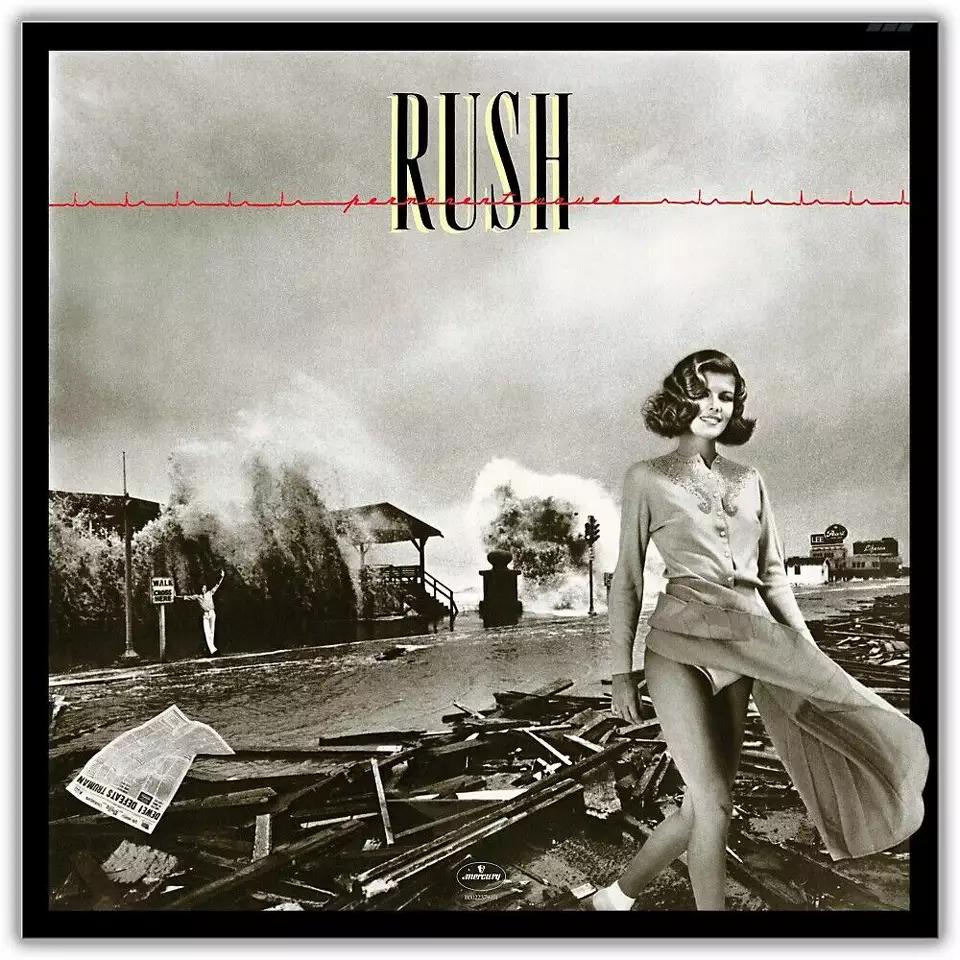The iconic cover of Rush’s 1980 album “Permanent Waves” is more than just an artistic representation of the band’s evolving sound—it’s a product of clever visual storytelling and historical references, including a surprising link to the devastating Hurricane Carla of 1961.
Designed by longtime collaborator Hugh Syme, the “Permanent Waves” cover uses a variety of visual puns that play off the album’s title and the concept of “waves.” Syme explained that the initial inspiration came from the 1950s home perm kits like the TONI home permanent wave products, which were all the rage during that era. He envisioned a “Donna Reed character” walking away from a tidal wave—something both literally and figuratively capturing the idea of “waves” in a playful manner.
The background photograph of the cover is an archival image by photographer Flip Schulke, taken during Hurricane Carla in 1961 along Seawall Boulevard in Galveston, Texas. Schulke, known for his fearless storm-chasing photography, was famous for securing himself to lamp posts and photographing extreme weather until it was too dangerous to continue. When Syme discovered Schulke’s work, he felt it was the perfect backdrop for the “Permanent Waves” cover and worked out an arrangement to use Schulke’s original negative.
The woman on the cover, Canadian model Paula Turnbull, is styled in a 1950s outfit with her hair perfectly coiffed, evoking the “permanent wave” hairstyle of that period. Turnbull would later reprise her role on Rush’s 1981 live album *Exit…Stage Left*. In the background of the *Permanent Waves* cover, Syme also included a newspaper blowing through the scene. This newspaper originally featured the infamous headline “Dewey Defeats Truman,” an erroneous report from the 1948 U.S. presidential election that symbolized the unpredictability and impermanence of politics—another subtle nod to the concept of “permanent” waves. However, legal concerns forced Syme to obscure the headline on later pressings of the album.
The cover was pieced together using pre-digital techniques. Syme and photographer Finn Costello manually cut figures from negatives and layered them onto a large-format sheet, using a collage-style approach. Each element—Turnbull’s image, the hurricane backdrop, and even a small photo of Syme himself waving in the background—was meticulously stripped and composited together, a labor-intensive process that underscores the creativity and technical expertise involved in creating album art before the advent of digital tools like Photoshop.
The “Permanent Waves” cover marked a turning point for Rush not only in terms of music but also visually. It was the first of many Rush album covers designed with a strong emphasis on visual puns, an approach that Syme would continue to explore throughout his work with the band. This particular design embodied the intersection of humor, history, and artistic commentary, setting a precedent for future collaborations. While the original concept—using EEG monitors to visually depict the band members’ brainwaves during recording—was abandoned in favor of the more playful final design, it’s clear that Syme and Rush were interested in pushing the boundaries of what album art could convey
Overall, the *Permanent Waves* cover encapsulates the spirit of Rush’s transition into a more concise, radio-friendly sound, as heard in tracks like “The Spirit of Radio” and “Freewill.” The album itself was pivotal in shifting the band’s direction from lengthy, complex compositions to shorter, more accessible songs while still retaining their progressive roots. This balance of innovation and tradition is mirrored in Syme’s cover art, which blends humor, social commentary, and a sense of timeless style [oai_citation:2,Designer Hugh Syme Tells The Story Behind Rush’s ‘Permanent Waves’](https://www.udiscovermusic.com/news/designer-hugh-syme-tells-the-story-behind-rushs-permanent-waves/) [oai_citation:1,How Rush’s ‘Permanent Waves’ Cover Fused Storms and Retro Hairdos](https://ultimateclassicrock.com/rush-permanent-waves-cover/).
No comments yet.







